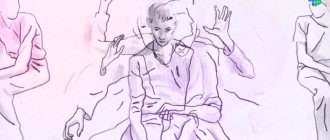| If you have discovered some of the described symptoms, this may indicate the development of a mental disorder. In this case, it is worth contacting a psychiatrist for diagnosis and initiation of timely treatment. In addition to face-to-face appointments , we offer a remote consultation service (online) , which is not inferior in quality to a personal meeting. Thus, you can receive qualified assistance from a high-level specialist, no matter where you are. |
Accompanying signs of the disease are: fear of self-worth, an oppressive feeling of emptiness (arising from difficulty in self-identification: what are my values, what do I believe in, what gives me pleasure), self-inflicted bodily wounds and dangerous behavioral patterns.
Derealization and depersonalization
Before determining the principles of treatment, specialists try to find out the mechanisms of functioning in as much detail as possible, as well as carry out diagnostic measures, including the following aspects:
- Consultation with a psychologist
- Conversation and comprehensive examination by a leading physician.
Treatment, as a rule, is prescribed comprehensively, which includes the use of medications, as well as psychotherapeutic work. All events are selected on a strictly individual basis.
The work of a psychologist primarily involves identifying the main reasons for which derealization-depersonalization manifests itself, as well as obtaining situational control of the situation and the symptoms displayed. Among the main and most common methods of therapeutic intervention are the following:
- Cognitive-behavioural
- Psychodynamic.
Regarding drug therapy, the most effective drugs are prescribed only after an individual examination. They are prescribed after identifying the reasons that could cause derealization-depersonalization. There are no specific medications in pharmaceuticals that could suppress the side symptoms of the disease.
When derealization or depersonalization occurs, the patient often begins to experience an overwhelming feeling of fear. However, all pathological manifestations can be effectively corrected.
Causes
In addition to psychogenic stress, for example, from overwork from an extremely large amount of information received, emotional distress, psycho-traumatic situations (rape, sexual seduction, beatings, humiliation, disasters, death or serious illness of loved ones, one’s own serious illness, war, captivity, torture), there are also other reasons for the development of depersonalization:
- alcohol poisoning;
- traumatic brain injuries;
- manifestation of temporal lobe epilepsy and some postictal conditions or preictal aura;
- hallucinogen intoxication ;
- taking dissociative drugs - NMDA receptor antagonists can even provoke a persistent full-blown disorder, for example the use of Ketamine , Dextromethorphan , Phencyclidine , as well as marijuana - causes characteristic symptoms after detoxification of the body;
- Iatrogenesis – erroneous diagnosis of an anxiety or depressive mental disorder in patients and the prescription of psychotropic drugs - antidepressants and antipsychotics that dull emotions or, on the contrary, an insufficiently assessed level of anxiety and depression and, accordingly, insufficiently prescribed drug therapy can lead to depersonalization; Therefore, the NODID Institute, a national organization whose activities are focused on the study of diseases provoked by drugs - Drug-Induced Disorders, is engaged in the development of effective methods for treating depersonalization-derealization in the USA.
Personality depersonalization syndrome
A distinctive characteristic of personality depersonalization is the inadequate perception and pathological perception of the individual’s own self. As a result, the patient ceases to feel like a person due to the occurrence of disturbances in the ongoing mental processes. As the disease develops, the individual’s personality begins to split into two halves: one takes an observational position, and the other takes an active position.
The first part functions in an isolated manner, that is, all the actions that the individual performs are not consciously realized. As a rule, a person thinks that the performance of any functions is carried out by external factors or other members of society. In addition, he is not able to perceive his own voice, physical body, but believes that they relate to another person. At the same time, the patient is able to express an objective opinion and sense reality.
It is important to note that the manifestation of a pathological syndrome cannot in every case be considered a mental disorder. Episodic phenomena, according to statistical data, occur in 70% of observed cases. They manifest themselves in the form of sensations when a person does not belong to himself or is not able to adequately assess the real world over a short period of time. In addition, even when systematic disorders occur, depersonalization cannot be equated with a mental disorder, since many people periodically experience a state as if the events that are happening are not happening to them, but to someone else.
Pathology includes only a stable state of mental illness or in the case when the symptoms are fixed in behavioral form for a long time.
General information
Depersonalization is usually called dissociative identity disorder , expressed in a violation of self-perception and alienation from one’s own “I” mental properties. Depersonalization occurs in approximately 1-2% of people and leads to a sideways perception of one’s own actions - when a person feels that he cannot control them, everything seems unreal and unfamiliar, this state turns into the phenomenon of derealization .
Typically, patients complain that they cannot control their mental activity and body, its parts, since they are qualitatively changed towards unreality, remoteness and automation. Depersonalization or absence of emotions can only be a manifestation of mental disorders such as schizophrenia , schizotypal , bipolar , panic , phobic , post-traumatic, obsessive-compulsive , depressive disorder , or the symptoms are so pronounced and aggravated that they represent a separate clinical variant of dissociative disorder - depersonalization syndrome - derealization , which is assigned the code MBK-10: F48.1.
Brief historical background
Depersonalization is a concept in social science that means depersonalization, the actual feeling of loss of “I”. The French psychiatrist Jean Esquirol first described depersonalization syndrome back in 1838, and in 1840 Moreau de Tours drew attention to the symptoms of alienation of one’s own personality and body in some of the patients examined. A more extensive study was carried out by Kriesgaber and described about 40 clinical cases in a monograph. The term “depersonalization” to denote alienation from one’s own “I” or its loss was proposed by the French philosopher Dugas in 1898, who also summarized all the data on this mental disorder.
When there are signs of loss of feelings and changes in one’s own “I”, giving way to feelings of emptiness, illusoryness caused by depersonalization, they speak of cenesthesia .
Symptoms and signs of depersonalization
Manifestations of depersonalization include the following symptoms:
- A feeling of confusion, the individual does not understand what is happening in his life and the world around him
- Feeling separate from yourself and the world around you
- Inadequate perception of the surrounding world. It can be perceived as drawn, unreal, fantastic
- The presence of an insurmountable barrier between the patient and society
- Parts of one's own body may be perceived as foreign. So, for example, a person may feel his hand as artificial, and an inadequate perception of shapes and sizes occurs. There are often complaints that the patient is unable to control his own body
- There is a decrease in intellectual activity
- Decreased emotional response. The patient is not able to experience deep feelings, there is a monotony of responses to ongoing events, or they are completely absent
- Often a person feels helpless, abandoned or lonely
- Lack of appetite, or the patient is unable to get enough of even an excessive amount of food
- Disorientation in time space. Lack of perception of time of day
- Lack of perception of one's own body or current events.
It is important to note that with the stable development of the disease, symptoms can persist for several years without remission. However, the patient always has criticism, since he realizes that his condition is inadequate, which causes burden, despondency and depression.
If manic-depressive psychosis is observed, specialists do everything possible to get rid of such a condition, and also try to identify a pattern: which illness arose in the first place.
Pathogenesis
The development of depersonalization is based on defense mechanisms, with the exception of some types of schizophrenia that cause alienation of the “I”, somatopsychic dissociation and mental anesthesia .
Typically, a disorder of the sense of one’s own body and personality is preceded by strong emotional shocks and stress , while the person tries to get rid of excessive negative stimuli, experiences and traumatic memories, to assess the situation soberly, impartially, unemotionally, so to speak, by distancing himself from his feelings and not analyzing them. The reaction is quite normal for the human psyche, but its long-lasting, painful course over many years indicates the pathological nature of the condition, which usually depends on the characteristics of etiogenesis and genetic predisposition.
Most often, the nature of depersonalization is transient, temporary, caused by stress, an excess of feelings, an overabundance of new information, while the state of “alienation” can pass in a matter of minutes. With a long, protracted course, at the beginning of the development of the pathology, “bright spots” may also appear - a kind of way out of the state with the disappearance of symptoms for several hours, then all the unusual feelings of alienation return.
The basis of the biochemical mechanisms of the development of depersonalization is the brain's response to a stress reaction in the form of abundant synthesis of endorphins , which have a high affinity for opioid receptors associated with dissociation reactions when using narcotic alkaloids of opium . In this case, there is a strong activation of opioid receptors and a change in the feedback mechanism responsible for neurochemical homeostasis from negative to positive, which causes cascade changes in groups of other receptor systems. As a result of blocking the pleasure center anhedonia , while the functional abilities of the limbic system, which is responsible for emotions, are switched off in response to chaotic stimulation and, in addition to the occurrence of a depersonalization-derealization reaction, depressive symptoms develop.
Treatment of personality depersonalization disease
The treatment process is selected individually in each case, taking into account the patient’s specific reactions and the characteristics of the body’s functioning. Includes drug therapy and work with psychotherapists. Medicines are prescribed only after determining the causes of depersonalization and a diagnostic examination.
Emotional depersonalization
A type of depersonalization, which is characterized by a partial or complete loss of emotional perception and, as a result, a lack of reactions to current events. Sometimes they are expressed in a monotonous form, which is why people around them are not always able to understand the patient.
It is important to note that the loss of emotions extends not only to the positive spectrum (joy, love), but also to the negative aspects (bitterness, disappointment). The result is manic-depressive syndrome. Or a phenomenon called “psychic anesthesia” occurs. According to statistics, the emotional type of depersonalization occurs with the development of a disease of the third category. However, this does not exclude the possibility of development in other types of disorders.
Often the disorder manifests itself in people with heightened emotional reactivity. Previously expressed emotions are preserved in their memory: love for loved ones and friends, joyful moments, experiences. But now nothing evokes emotional responses. Works of art or music do not evoke past admiration or any thoughts. The person becomes indifferent to past activities and hobbies. The mood also cannot be classified into any category: neither negative nor emotional. The surrounding world does not cause any interest, because it loses its expressiveness in front of a person suffering from depersonalization.
With the somatic manifestation of the disease, pain may occur, food loses its taste, tenderness and touch no longer cause any emotional reactions. The disease also has a negative impact on intellectual activity, thinking and memory. After a short period of time, a person no longer remembers what goals and objectives he set for himself. And although the very fact of the events remains in the memory, it no longer has an emotional connotation.
In practice, the onset of mental anesthesia is diagnosed in adults (most often females) on the basis of a developing depressive state. In addition, such behavior can be a side effect of long-term use of prescribed psychotropic medications.
Autopsychic depersonalization
A characteristic feature of this type of depersonalization is a complete lack of awareness of one’s own “I”, and there is also no emotional component. Among the main complaints are the following: a person ceases to perceive his own thoughts, reactions to ongoing events and interactions with other people remain without emotion, and sometimes are completely absent.
Autopsychic depersonalization involves the loss of natural self-awareness, a sense of one’s own Self. All reactions come down to an automatic reaction. However, a person is aware of pathological changes, so there is no feeling that his consciousness is guided by higher powers. Despite the automaticity of all actions, a person fully understands that they are initiated by himself.
The development of pathological psychological anesthesia is also considered characteristic, since a person completely and to a greater extent loses any kind of emotional response (positive or negative). Similarity of reactions is found regardless of the situation. As a rule, most patients worry precisely because of the loss of emotional response.
All events and experiences are perceived as if they were happening to another person. The patient begins to observe the ongoing changes and events from the outside, taking the passive side. When the condition seriously deteriorates, the personality splits into several components. There is a feeling that someone else lives in a person besides him. Inconsistency in actions, reactions, and different ways of thinking appear.
This form of the disease is also characterized by panic and anxiety, which arises as a result of awareness of a mental disorder that has a destructive role in his life. There is also a reverse reaction, when a person does not want to admit the fact of the presence of a disease, as well as spreading pathological forms. Most often this happens due to the fear that the person is beginning to lose consciousness.
In psychiatric practice, one can often find another development of the situation when the disease proceeds more smoothly. The disease progresses gradually, without sudden jumps. Among the most common complaints of patients is the loss of their own self, and there is also a feeling that the person is becoming a similar copy of himself and observing his life from the outside.
Since autopsychic depersonalization causes serious damage to the emotional sphere and normal communication with other people, the patient often begins to minimize contact with relatives and friends. There are difficulties in remembering which activities were favorite; often a person can freeze in one groove for an indefinite period of time.
A severe form of the disease most often occurs in patients suffering from other mental disorders, for example, schizophrenia and cerebral pathologies.
Depersonalization of VSD
Among the main symptoms of the development of depersonalization in VSD, the following aspects can be distinguished:
- Getting insufficient oxygen
- Prevalence of depression
- Temperature increase
- Dizziness occurs frequently
- Migraines of varying degrees of intensity.
As a rule, the development of dystonia often provokes a feeling of constant fatigue and weakness. In addition to complaints of impaired self-awareness, pain in the limbs also occurs. Most patients who have suffered from VSD for more than a year react especially acutely to weather changes.
The principles of treatment depend on the degree of development of the disease. Most often, inpatient treatment is carried out if uncontrollable fear develops, not a single medication helps in the fight against migraines, and self-control does not bring any results. In a critical situation, specialists can prescribe strong antipsychotics, sedatives, and tranquilizers.
To enhance the positive effect of treatment, it is also recommended to use additional therapeutic methods:
- Completion of complex massage activities
- Physiotherapeutic activities
- Acupuncture
- Use of antidepressants.
No less important is working with qualified psychologists who are able to help the patient solve the problem, stabilize his condition, and also find out the main causes of depersonalization.
Somatopsychic depersonalization
According to the theory of Yu.L. Nuller, somatopsychic depersonalization most often begins to develop in the initial period of the disease in its acute form. Among the most characteristic side symptoms that patients most often complain about is the lack of sensation of their own body or individual parts. Often ideas arise that the arms or legs have changed their shape or size.
Often the patient has the idea that he is missing clothes, they do not feel their touch on the body. However, objective sensitivity is not diagnosed, since the person continues to feel pain signals and the touch of another person. But the process takes place detachedly without any emotions. In addition, no physiological changes are detected in the limbs. Despite the fragmentation in their own sensations, patients understand reality and that their body has remained unchanged in shape.
The manifestation of a somatopsychic type of disorder can also include an absolute loss of the feeling of hunger or satiety. This is due to the fact that the previously most favorite dish no longer gives any satisfaction or positive emotions, so often a person becomes completely indifferent to eating and most often completely forgets to eat at the appointed time. As a result, not only the cyclical functioning of the body is disrupted, but side diseases associated with the functioning of the gastrointestinal tract may occur.
It is important to note that fulfilling any biological needs does not bring any satisfaction or relief, so often the patient begins to remember the need to perform some action when absolutely necessary, when the body begins to give signals.
For example, when taking a bath, complaints often arise that a person does not feel moisture on his skin or whether the water is used: hot or cold. Often the patient is not able to determine whether he has slept, since the feeling of rest is constantly absent. When visiting a psychotherapist, some people claim that they have gone without sleep for six months.
Somatic disorders cannot be avoided. Most often they are expressed in painful sensations in the back, spine, and headaches of varying intensity. At the slightest suspicion of depersonalization, the patient is subjected to a competent and comprehensive examination, since if the diagnosis is not dealt with, this can lead to the appearance of hypochondriacal delusions and split personality.
Cognitive behavioral therapy
To treat a woman or man, cognitive behavioral therapy is often used. This approach is aimed at helping the patient get rid of rituals associated with the constant assessment of his shortcomings. During the treatment process, self-reflection is necessary:
- tracking your condition;/li>
- recording the occurrence of negative thoughts;/li>
- overcoming negativity.
Cognitive behavioral therapy is aimed at making the patient fully aware of his condition and the dangerous consequences for health. This is the main condition for successful recovery. This method can be combined with medications or other types of therapy.








